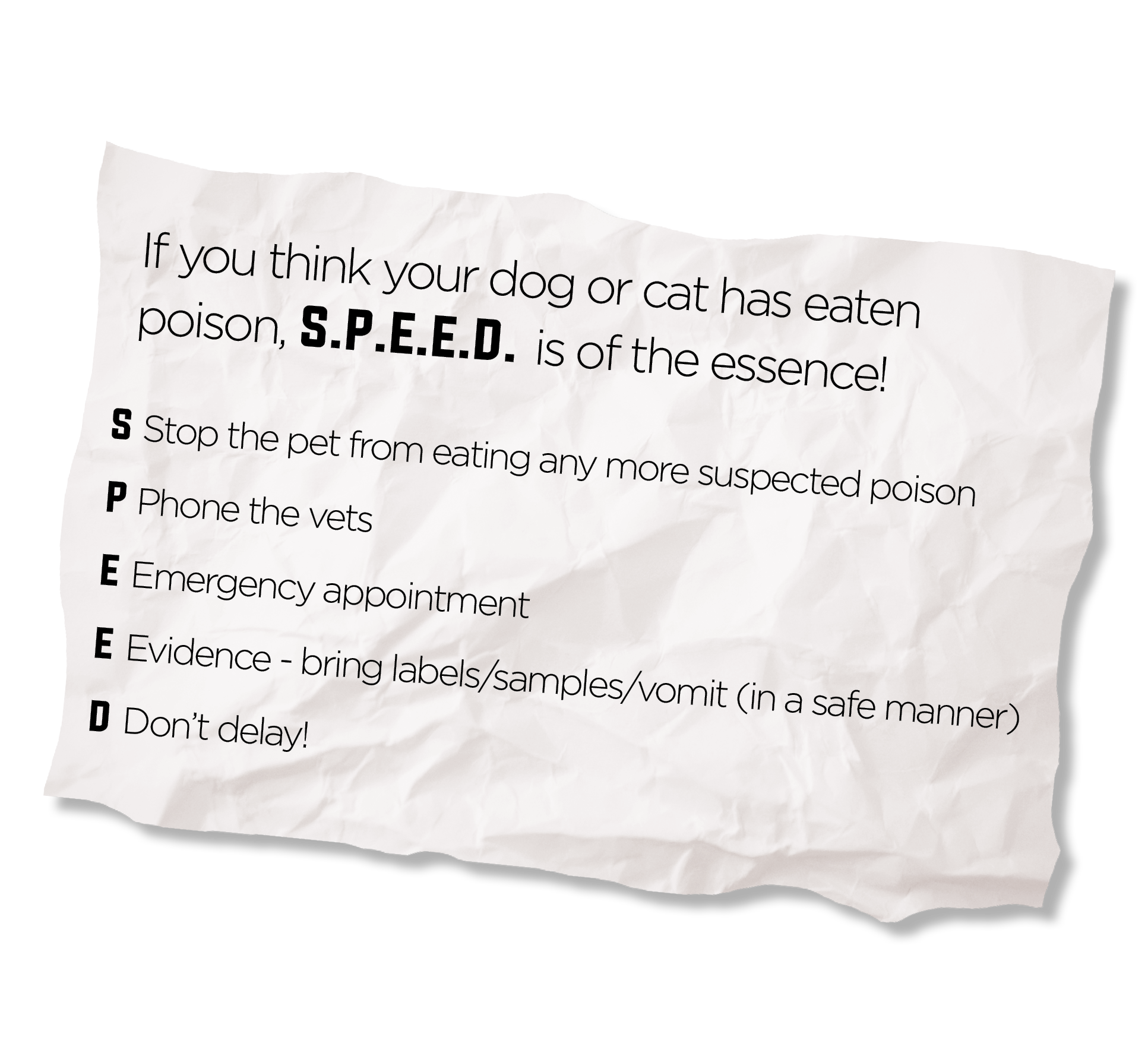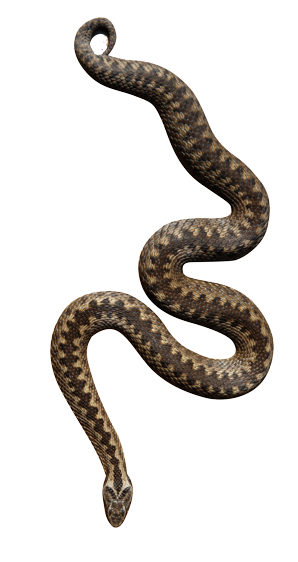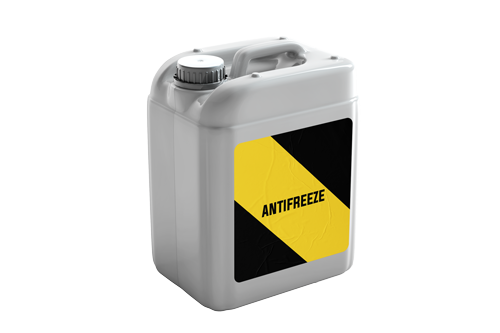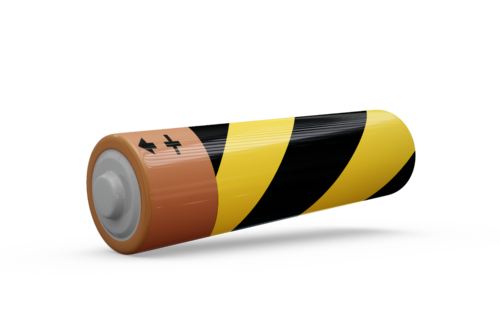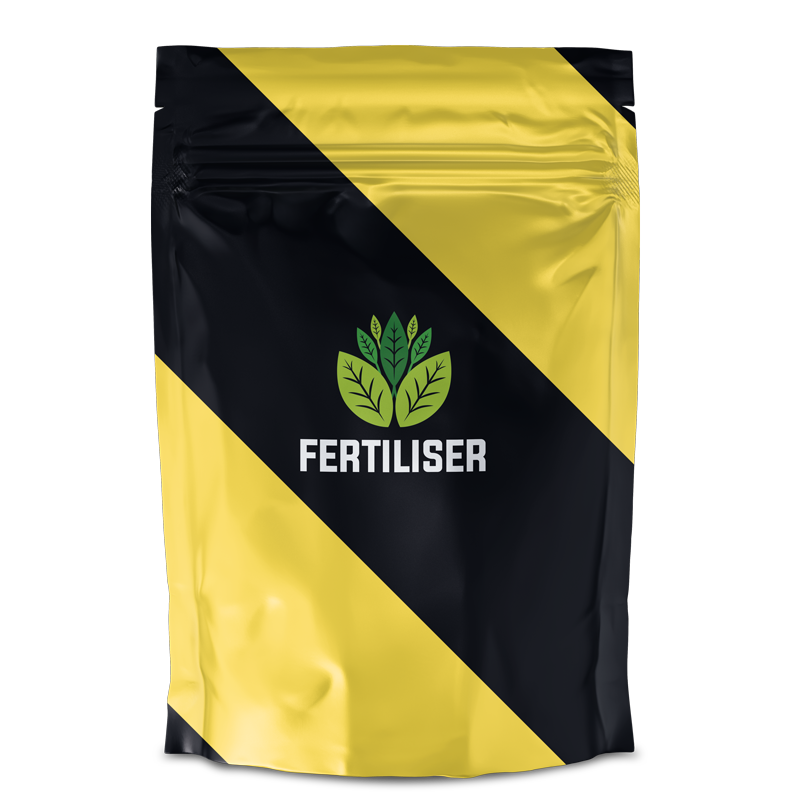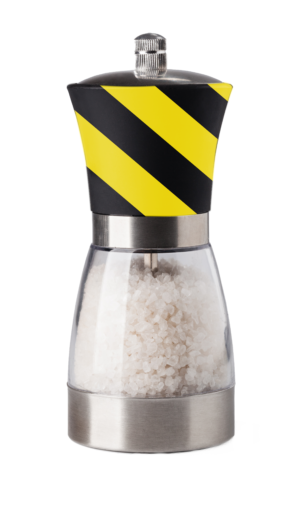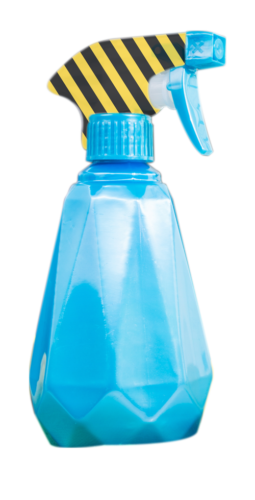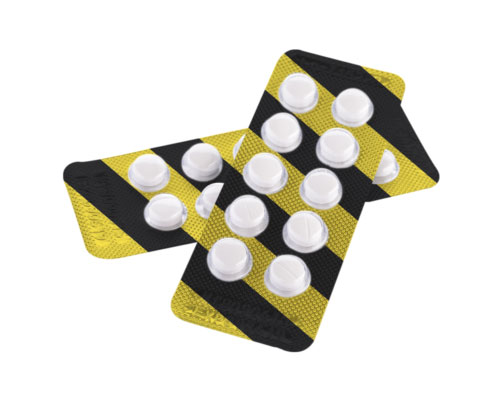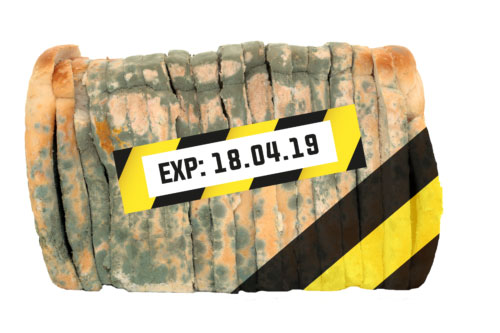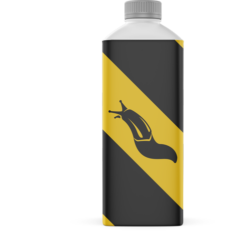Page - Common Pet Poisons
Our houses and our environment are full of ‘dangers hidden in plain sight’ for our pets. You may not even know that many would be a problem. However, simply having awareness of the common poisons out there will help towards keeping your pets as safe as possible. Always consult your vet if you think your pet has ingested anything that they shouldn’t have.
Common pet poisons around the home and garden.
Adders are the only venomous snake in the UK. They become active in the warmer months, following a winter hibernating. Pets are usually bitten on the legs, head or neck.
Adder bites can result in rapid, painful swelling and bruising. You may also be able to identify two small puncture holes in the centre of the swelling. If your pet has been bitten on their leg, they may also become lame. Bites can be ‘dry’ (no venom injected) or venomous. If the bite is venomous, additional signs may be experienced; lethargy, vomiting, panting, collapse, pale gums, drooling, bleeding, abnormal heart rhythm and kidney problems.
What to do if you think your pet has been bitten?
- Don’t panic!
- Do not interfere with the bite or apply a tourniquet.
- Don’t try to catch or kill the snake.
- Seek veterinary advice -carry your pet to your car (if practical) and don’t delay treatment, even if your pet appears well.
Most dogs will make a quick and complete recovery, provided they are treated promptly, so don’t delay in seeking veterinary advice!
How can I prevent my pet from being bitten?
It is difficult to eliminate the risk of Adder bites, but you can take extra caution during summer months when snakes are more active. Be careful when walking with your pet in long grass, sandy dunes or around rocks or stone walls where Adders tend to sleep. Keep your dog on a short lead when walking in these areas.
Know what to look for:
Adders have a dark brown/black zig-zag pattern along their back and may have a pale grey to olive green colour elsewhere. Adult snakes are 50-60cm long and have vertically slit pupils (other native non-venomous snakes have round pupils).
Most of us know are familiar with the toxic effect alcohol can have on our bodies, but what about our pets?
Cats and dogs are actually much more sensitive to alcohol than humans are, and can be readily poisoned by ingesting alcoholic drinks or liquor chocolates. Pets can even suffer alcohol poisoning by ingestion of unfermented yeast products (commonly unbaked bread dough) – as the yeast ferments in the warm environment of their stomach, the alcohol created by the process passes quickly into their blood stream resulting in alcohol poisoning.
Alcohol poisoning can lead to dangerous drops in blood sugar, blood pressure and body temperature and can lead to seizures and respiratory failure if severe. Signs to watch out for include:
- Lethargy/tiredness
- Wobbliness
- Muscle twitching
- Collapse
- Seizures (fits)
- Cold extremities
- Difficulty breathing
Always consult your vet as soon as possible if you think your pet has ingested anything that they shouldn’t have.
Antifreeze is extremely toxic to dogs and cats
Why is Antifreeze poisonous?
Antifreeze contains the substance Ethylene glycol. The same substance is also found in radiator coolant, motor oils, hydraulic brake fluid, paints, solvents and photography developing solutions.
How many of us use antifreeze to add to our windscreen wash or as a de-icer spray?
How careful are we when we add it or about where we store it?
Is antifreeze really that dangerous to dogs and cats?
Yes!
As little as 1 tablespoon is enough to cause kidney failure in a dog
As little as 1 teaspoon is enough to kill a cat
What are the symptoms of antifreeze poisoning in dogs and cats?
Symptoms include
- Drunken-like behaviour
- Incoordination
- Excessive drinking or urination
- Drooling
- Vomiting
- Panting
- Sedation/depression
- Halitosis (bad breath)
- Lethargy/tiredness
- Lack of appetite
- Seizures
- Coma
- Acute kidney failure
- Death
The symptoms occur in 3 stages as the poisoning progresses:
Stage 1
- 30 minutes to 12 hours after ingestion: Similar to alcohol poisoning (vomiting, incoordination, drooling, excessive drinking and urination, seizures)
Stage 2
- 12-24 hours after ingestion: The animal seems to get better but deterioration is occurring internally
Stage 3
- 12-24 hours after ingestion in cats, 36-72 hours after ingestion in dogs: severe kidney failure (lack of appetite, lethargy, drooling, bad breath, coma, depression, vomiting, and seizures).
I think my dog or cat has drunk anti-freeze, what should I do?
You must take your pet to the vet immediately. If you leave it too long, it may be too late.
Your vet only has a short, limited time frame to try to minimise the absorption of poisons before they can cause harm and so an immediate appointment is essential and potentially life-saving.
S.P.E.E.D. is key, for more information on what to do if you suspect a poisoning, click here.
Batteries can pose a risk to pets in a number of ways, and are a hazard to be extra vigilant about during certain times of year such as Christmas as they may be in abundance for kids toys etc. Pets may be attracted to their shiny nature and chew or even swallow them. If swallowed without being chewed they may pass through without causing harm if small enough, however larger batteries may be enough to cause gastrointestinal obstruction in smaller pets.
Further risks also depends on the type of battery, where severe burns and gastrointestinal damage can occur very rapidly:
Alkaline dry cell batteries
- Usually used to power torches, toys and other household items
- Contain a corrosive material which generates current so if chewed and swallowed they can cause chemical burns to the mouth, oesophagus and stomach/intestines
Lithium batteries
- Typically, round disc type batteries used in watches, cameras and other household items
- Non-corrosive and generate power via an electrochemical process
- If they become lodged can cause severe electrical burns to the gastrointestinal tract even if not chewed
If you suspect a battery has been ingested by your pet you must seek veterinary attention immediately and note down the type of battery involved (take in an example if possible).
Did you know that spring bulbs can be harmful to our pets? Plants to look out for include; snowdrops, bluebells, daffodils (narcissus), hyacinths, tulips, irises and crocuses.
Plant bulbs contain irritant chemicals called alkaloids, which can be toxic to your pet. The chemicals are most concentrated in the bulb of the plant, however particularly for some plants (such as daffodils), ingesting any part of the plant can be harmful.
Symptoms of ingestion typically include; drooling, nausea (feeling sick), vomiting, diarrhoea and abdominal pain. Severe cases can result in; abnormal breathing, increased heart rate, abnormal heart rhythms, low blood pressure, organ damage and seizures. Left untreated, this has the potential to be fatal, so it is very important to seek urgent veterinary advice if you witness or suspect your pet has ingested any part of the plant, including water in vases containing plants (e.g., daffodils).
The severity of toxicity depends on both the type of plant ingested and the quantity, therefore it is useful to identify what plant your pet may have eaten and how much. This is why it is reccomended to take photos or samples along to your vet.
Always consult your vet as soon as possible if you think your pet has ingested anything that they shouldn’t have.
Is all chocolate bad? Yes – Chocolate is poisonous to both cats and dogs.
The higher the cocoa content, the more toxic the chocolate.
Therefore darker chocolate and better quality chocolate are most toxic.
Did you know that some good quality milk chocolate can be up to 65% cocoa? That’s higher than some dark chocolate!
You should never take the risk if your pet has eaten chocolate, get them seen by a vet straight away (never wait or it could be too late).
What are the symptoms of chocolate poisoning?
- Vomiting – may even include blood
- Diarrhoea
- Breathing rapidly
- Restlessness
- Hyperactivity
- Increase heart rate and breathing rate
- Rigid muscles
- Incoordination
- Seizures
Why is chocolate poisonous?
Chocolate contains substances called methylxanthines (theobromine and caffeine), which are extremely toxic to our pets. Their bodies can’t deal with them the same as ours can which is why you should never give your pet access to chocolate.
Chocolate poisoning rockets over the Easter and Christmas periods, when as a nation we have more chocolate around the house. Always be vigilant and make sure chocolate is out of the reach of prying paws.
What should I do if I think my dog has eaten chocolate?
Your vet only has a short, limited time frame to try to minimise the absorption of poisons before they can cause harm and so an immediate appointment is essential and potentially life-saving.
Click here to follow our advice
ALWAYS KEEP CHOCOLATE AWAY FROM PRYING PAWS: NEVER GIVE CHOCOLATE AS A TREAT (no matter how small a piece, as your dog may get the taste for it and steal some at a later date)
Whilst Christmas decorations are pretty to look at they can pose a risk for inquisitive pets wanting to play. The common festive culprits to watch out for are:
- Tinsel – shiny and attractive to pets, especially cats! If ingested it can cause severe blockages and damage in the intestine, requiring surgical removal.
- Baubles – dogs and cats may think they are fun toys to play with, however if they smash in their mouths they can cause severe cuts. Ingested whole they can cause gastrointestinal blockage
- Fairy lights – if chewed can cause electrocution. House rabbits and puppies in particular are often inquisitive and active chewers so keep fairly lights out of reach
- Pine cones – can cause damage to the mouth if chewed and gastrointestinal obstruction
- Salt dough decorations – often children will make homemade salt dough decorations at Christmas time to hang on the tree. However, pets may think they are treats and eat them with disastrous consequences due to the highly toxic levels of salt contained within them. For symptoms of salt intoxication see the Home Made Play dough/salt dough section.
- Christmas plants – see Plants & flower section.
Why are cigarettes and E-cigarettes so poisonous to dogs and cats?
Nicotine is toxic to pets. Cigarettes, E-cigarettes and vapers and their refills contain nicotine and can cause nicotine poisoning in pets if chewed and/or eaten.
One e-cig can contain as much nicotine as more than one pack of cigarettes, so the concentration is a concern.
The variety of flavours they are now available in make them even more interesting to our inquisitive pets.
As the popularity of these devices has increased, unfortunately so has the reported incidence of accidental poisoning in our pets.
What are the symptoms of e-cigarette poisoning in dogs and cats?
Symptoms include:
- Vomiting
- Diarrhoea
- Agitation
- Increased heart rate and breathing rate
- Depression
- incoordination
- Weakness
- ‘Turning blue’ (cyanosis)
- Coma
- Death
Symptoms occur very quickly after ingestion – usually within 15 minutes to one hour.
My dog has eaten an e-cigarette or a refill, what should I do?
Your dog needs to be seen by a vet immediately as this could be a life-threatening poisoning.
Your vet only has a short, limited time frame to try to minimise the absorption of poisons before they can cause harm and so an immediate appointment is essential and potentially life-saving.
For more information on what to do if you think your pet may have been poisoned, click here.
Always keep these products out of the reach of prying paws!
Before reaching for lawn fertilisers, weed and moss killers, it is important to consider the safety of using these products around our pets.
There are lots different chemicals used in herbicides which can be harmful to your pet. Common compounds include; glyphosate, surfactants (quaternary ammonium compounds, chlorophenoxy derivatives), fatty acids (pelargonic acid) and ferrous sulphate. In order to provide a convenient, multipurpose product, some manufacturers will include several active ingredients.
Your pet may be exposed through ingestion (eating treated grass or licking paws after walking on treated areas), inhalation (if sprays used) or through contact with their skin.
Signs of exposure include;
- Skin irritation
- Mouth ulcers
- Drooling and nausea
- Vomiting, diarrhoea and abdominal pain
- Lethargy and weakness
- Reduced appetite
- Tremors
If you witness or suspect your pet has ingested chemicals used in your garden, it is important to contact your vet straight away or call the Animal PoisonLine on 01202 509000. It is helpful to provide details of the product that you have used in order for your pet to be treated optimally.
Treatment of herbicide poisoning is supportive and most pets will make a full and rapid recovery. Prevention is better than cure, so it is advisable to try to avoid your pets coming into contact with these chemicals in the first place. Practical advice includes; manually removing weeds, using pet-safe products, making sure products are kept in a secure place that your pet cannot access, always follow the manufacturer’s instructions, wiping your pet’s paws when they come in from the garden and prevent them from eating grass or plants in the garden.
Grapes, raisins, currants and sultanas can be poisonous to dogs.
Why are they poisonous?
No one has yet discovered the specific mechanism of poisoning but we do know that they can cause acute kidney failure in some dogs.
The toxic ‘dose’ has not been determined as it is unpredictable – for those dogs affected some may need to eat only a few grapes (or their dried fruits) to be affected, whereas some dogs have a higher tolerance. Also, just because your dog may have once eaten grapes before and been fine, if they ingest them again in the future this may not be the case so it is always best to act with caution and seek veterinary attention whenever ingestion occurs.
DON’T TAKE THE RISK WITH YOUR PET
Are they ok if cooked? No!
Look out for ingredients containing these items such as fruit cake, christmas cake, mince pies, hot cross buns etc and never feed these to your pet.
What are the symptoms of grape and raisin poisoning?
Symptoms include:
- vomiting and diarrhoea (possibly with blood present)
- excess salivation/slobbering
- poor appetite
- increased drinking/urination
- weakness/wobbly when walking
- lethargy/tiredness
- bad breath
- dehydration
- blood in the urine
I think my dog has eaten grapes or raisins what should I do?
Contact your vet immediately and make an emergency appointment, no matter what time of day.
Your vet only has a short, limited time frame to try to minimise the absorption of poisons before they can cause harm and so an immediate appointment is essential and potentially life-saving.
S.P.E.E.D. is key (for more information on what to do when your pet has eaten something it shouldn’t have, click here)
Never give your pets raisins/grapes/currants/sultanas or foods containing them
Keep them away from prying paws!
Why is home made play dough/salt dough so highly poisonous to dogs and cats?
The main ingredients are salt and food colouring. If a dog or cat accidentally eats it, they can suffer from salt poisoning.
What are the symptoms of salt poisoning?
Symptoms include:
- Vomiting
- Diarrhoea
- Inappetance
- Lethargy
- Walking drunk
- Abnormal fluid accumulation within the body
- Excessive thirst or urination
- Tremors
- Seizures
- Coma
- Death
What should I do if I think that my pet has been poisoned?
Your vet only has a short, limited time frame to try to minimise the absorption of poisons before they can cause harm and so an immediate appointment is essential and potentially life-saving.
For more information on what to do if you suspect any poisoning, please click here.
Many household cleaners are toxic to pets
Should I worry?
Always make sure that you keep cleaners out of the way of all pets (and children), not only can pets get direct access but there have also been occasions whereupon children have thought that they were giving their pet a treat, when infact they were giving the pet a laundry detergent pod. Don’t let this happen to you, keep everything out of the reach and sight of small hands and paws.
Kinds of products to look out for include:
- Laundry cleaning liquids and pods
- Dishwasher liquids and pods
- Toilet, drain, oven cleaners
- Bleach
- Spray cleaners
- Disinfectants
- Limescale removers
- Many more
In fact most cleaners and detergents are very harmful if eaten and you should take action if you think your pet has had access to any of this type of agent.
What are the symptoms?
They very much depend on what has been ingested but range from mild stomach upsets to breathing problems and severe, life-threatening internal burns.
What should I do if I think my pet has had access to these types of product?
You need to make an emergency appointment with your vet. There is no time for delay in this (or any) type of poisoning. For the best chance of treatment and recovery you need to see a vet immediately and bring the packaging or label with you to show what has been ingested.
For more information on what to do when faced with poisoning, please click here.
Human medications can be highly poisonous to dogs and cats
A real problem
Human medication is the biggest reported cause of accidental poisoning in dogs and cats.
Not only are dogs and cats much smaller than us and so an overdose is easier, but dogs often chew ‘whole packets’ of medication, absorbing dangerously high doses. In addition, many medicines which may help us, are actually toxic to dogs and cats to begin with. For example did you know that paracetamol is deadly to cats?
Never give your pet human medication on purpose as their body systems are very different to ours, whilst you may be trying to help, you could actually cause serious harm.
Medicines for pets are very specific and unlike ours, the dose is tailored very accurately to their weight in Kg.
Symptoms would be very difficult to list as they will be very much dependant on the medicine responsible.
I think my pet has eaten my medication, what should I do?
This is not a ‘wait and see’ moment, you must take your pet to the vet immediately and bring the medical packaging with you, so that the vet can give appropriate treatment.
Your vet only has a short, limited time frame to try to minimise the absorption of poisons before they can cause harm and so an immediate appointment is essential and potentially life-saving.
For more information on what to do if you suspect your pet has eaten something poisonous, please click here.
Mouldy food can be toxic and even deadly to dogs and cats
Why should I worry about mouldy food?
When eaten, mouldy food can poison your pet due to mycotoxins that are present in mould.
Always keep bins secured and compost heaps out of the way of your pets. If your dog is a scavenger take extra care on walks in case of discarded food or overturned bins. Even licking the inside of bins that have a coating of mould is dangerous and has led to deaths.
I think my dog has eaten mouldy food what should I do?
Contact your vet immediately and make an emergency appointment, no matter what time of day.
Your vet only has a short, limited time frame to try to minimise the absorption of poisons before they can cause harm and so an immediate appointment is essential and potentially life-saving.
S.P.E.E.D. is key (for more information on what to do when your pet has eaten something it shouldn’t have, click here)
What are the symptoms of mould toxicity?
Symptoms include:
- Muscle tremors
- Seizures (fits)
- Panting
- Hyperactivity
- Vomiting
- Uncoordinated movements
- Weakness
- Dehydration
- Lack of appetite
Onions, garlic, leeks and chives are actually poisonous to dogs and cats.
Wait, really?
Yes, when eaten in moderate amounts or routinely, these foods actually cause problems with blood cells and anaemia (low red blood cells).
If your pet gets to a pan cooking these substances it could result in poisoning. Garlic pills and powders should be avoided for the same reason and specialist pet poison centres recommend that you not give these products.
How much is enough?
Why even take the risk? Don’t forgot not only can moderate amounts be a risk but also routinely giving them can also cause problems.
Ingestion of the equivalent of over 0.5% of a dog’s bodyweight can result in poisoning (i.e. a 15kg dog would only need to eat 75g to be in trouble).
Certain breeds of dogs (e.g. Japanese breeds such as the Akita, Shiba Inu etc) and cats are EVEN MORE susceptible to poisoning that this!
Don’t take the risk!
What are the symptoms of onion/garlic/leek/chive poisoning?
Symptoms include:
- Smell of the food on the breath
- Pales mucous membranes (gums, inside of eyelids etc)
- Lethargy/tiredness
- Increase breathing and heart rate
- Vomiting
- Reduced appetite
What should I do if I think or know my pet may have been poisoned?
You should take your pet to the vet immediately for emergency treatment for the best chance of a recovery. Your vet will try and make your dog vomit to remove as much poison as possible before it is absorbed, the vet can only do this within a short time period so S.P.E.E.D of action is key!
To find out more about what to do if your pet has been poisoned, please click here.
Many plants and flowers can be poisonous to dogs and cats
Many indoor and outdoor plants can be poisonous to pets if eaten. Inquisitive pets can chew or swallow flowers, pollen, leaves, roots or bulbs and then become poisoned. Please see a list of plants and flowers that may be toxic to dogs and cats below. It is always a good idea to check with your garden centre or florist before purchasing plants or flowers to check that they are pet safe.
Lilies, in particular, are extremely toxic to cats -they often become poisoned by grooming the pollen from their coat if they accidentally brush against the flowers. However, any part of the plant if ingested can cause rapid and fatal kidney failure so it is not worth the risk of having them in your home if you own cats.
It is also worth being aware of seasonal plant dangers. For example, did you know that the following Christmas time plants and flowers are dangerous for you pet?
- Holly
- Ivy
- Mistletoe
- Poinsettia
- Pine Cones
- Xmas Tree Needles
Which plants are poisonous to dogs?
Whilst not an exhaustive list, the most common can be found below:
- Aconitum
- Amaryllis bulbs
- Asparagus fern
- Azalea
- Cyclamen
- Daffodil bulbs
- Day lilies
- Delphiniums
- Foxgloves
- Hemlock
- Hyacinth
- Hydrangea
- Ivy
- Laburnum
- Lily of the valley
- Lupins
- Morning glory
- Nightshade
- Oleander
- Rhododendron
- Rhubarb leaves
- Sweet pea
- Tulip bulbs
- Umbrella plant
- Wisteria
- Yew
A fantastic longer list of poisonous plants and the associated symptoms can be found here by the Dog’s Trust.
Which plants are poisonous to cats?
Whilst not an exhaustive list, examples can be found below:
- Amaryllis (Amaryllis sp.)
- Autumn Crocus (Colchicum autumnale)
- Azaleas and Rhododendrons (Rhododendron sp.)
- Castor Bean (Ricinus communis)
- Chrysanthemum (Chrysanthemum sp.)
- Cyclamen (Cyclamen sp.)
- English Ivy (Hedera helix)
- Kalanchoe (Kalanchoe sp.)
- Lilies (Lilium sp.)
- Marijuana (Cannabis sativa)
- Oleander (Nerium oleander)
- Peace Lily (Spathiphyllum sp.)
- Pothos (Epipremnum aureum)
- Sago Palm (Cycas revoluta)
- Spanish thyme (Coleus ampoinicus)
- Tulip and Narcissus bulbs (Tulipa and Narcissus sp.)
- Yew (Taxus sp.)
A longer list can be found on the icatcare website here.
I think my pet may have eaten something poisonous, what should I do?
If you think your pet has eaten ‘anything’ poisonous, you should take your pet to the vet immediately.
Your vet only has a short, limited time frame to try to minimise the absorption of poisons before they can cause harm and so an immediate appointment is essential and potentially life-saving.
S.P.E.E.D. is vital.
To find out more about what to do if you suspect your pet has been poisoned, please click here.
Rat poison is extremely toxic to dogs and cats and can be fatal
What is rat poison?
The most commonly used class of rat poison in the UK is what is called an ‘anticoagulant’ poison (this article refers to this type of poison only). It stops the blood from clotting and causes the rat to bleed to death.
Unfortunately, the same symptoms can occur in any animal that eats it.
Can rat poisoning be treated? Yes – but you must act immediately!
If you get to the vet quick enough, there is an antidote- which will need to be given for as long as the poison remains in the body. This will likely be for several weeks and until the blood can clot on it’s own again. It is ESSENTIAL that the antidote is given for the length of time the poison is present in the body, or the animal will start to bleed again if the treatment is taken away too soon.
If you get to the vet very quickly he or she may even be able to make your dog vomit as much of the poison out as possible, before it can all be absorbed.
Success depends on prompt treatment, as if an animal is bleeding severely there is only so much that can be done to save them.
What are the symptoms of rat poisoning?
It is important to know that symptoms do not start for several days but you should NEVER just ‘wait and see’. If you see or suspect your dog has eaten rat poison you must take them to the vets immediately, the sooner they receive treatment, the better the chances of a complete recovery.
After a few days symptoms start to appear, however they can be very vague, such as:
- Pale gums (all mucous membranes)
- Weakness, tiredness, depression
- Lack of appetite
- Shock and collapse
or very specific and related to bleeding in a particular part of the body, such as:
- Breathing symptoms – cough, difficulty breathing
- Blood in the faeces (they will look black or have obvious blood in them)
- Blood in the urine or vomit
- Bruising, swellings
- Appearance of red dots in various places (petechiae)
- Labial, conjunctival (eye) bleeding
- Limping, swelling of limb
- Nose bleeds
- Sore tummy
- Seizures
- Increased heart rate
- Many more
My dog has eaten rat poison what should I do?
Your vet only has a short, limited time frame to try to minimise the absorption of poisons before they can cause harm and so an immediate appointment is essential and potentially life-saving.
Follow our guidance here
My dog has eaten rat poison but seems fine, should I do anything?
YES!!! Act immediately.
Whilst your pet may have no outward signs yet, internally all the processes that cause their blood to clot are failing and outward symptoms could begin at any moment. Get them to the vet immediately, before it is too late.
What does rat poison look like?
The bait has many forms such as: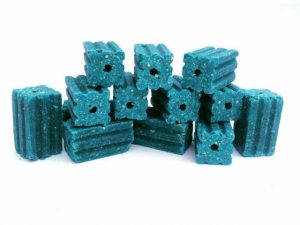
- Pellets (see main picture above)
- Powder
- Blocks (see right)
- Grains/cereals
It also can be different colours such as blue, green, red and yellow/beige.
It also can be different colours such as blue, red and beige.
Slug bait is highly poisonous to dogs and cats
Why is slug bait poisonous?
Slug bait is commonly found as pellets, liquid or powder and contains the toxic ingredient ‘metaldehyde’. It is often also sweetened which makes it attractive to our pets.
What are the symptoms of slug bait poisoning in dogs and cats?
Metaldehyde is converted to a product in the body called acetaldehyde which has effects on the nervous system.
Symptoms include:
- Muscle tremors/twitching
- Lack of coordination
- Anxiety
- Drooling
- Panting
- Vomiting
- Seizures
- Hyperthermia (dangerous increase in body temperature)
- Uncontrolled blood clotting (a condition called disseminated intravascular coagulation or DIC)
- Multiple organ failure
- Death
Symptoms can occur within minutes to hours after ingestion.
I think my pet has eaten slug bait what should I do?
This is an emergency and cannot wait- you must get your pet to the vet immediately. The vet will try to get as much poison out of the body as possible but only has a limited amount of time to do so and your animal will need medical treatment to support it for the best chance of a recovery.
For more information on what to do if you think your pet has been poisoned, click here
Xylitol (also known as E number E967) is highly poisonous to dogs
What is xylitol?
Xylitol is an artificial sweetener found in many substances such as
- Sugar free chewing gum
- Mints
- Toothpaste and other dental products
- Sugar free baked goods, sweets and other confectionary items
- Diabetic foodstuffs
- Some peanut butters – check carefully which peanut butter you put in dog treat toys!
- Jams
- Ice creams
- Sugar free vitamin supplements, fish oils etc
Why is Xylitol poisonous to dogs?
Smaller doses can cause a sudden, life threatening drop in blood sugar within minutes of ingestion.
Larger dose can cause severe damage to the liver and liver failure.
What are the symptoms of Xylitol poisoning?
- Weakness
- Lethargy (tiredness)
- Collapse
- Vomiting
- Tremors
- Seizures
- Jaundice (yellowing most obvious in the whites of the eyes and gums)
- Malaise (no energy)
- Black-tarry stool
- Coma
- Death
I think my pet has eaten xylitol, what should I do?
Your vet only has a short, limited time frame to try to minimise the absorption of poisons before they can cause harm and so an immediate appointment is essential and potentially life-saving.
Follow our advice here

